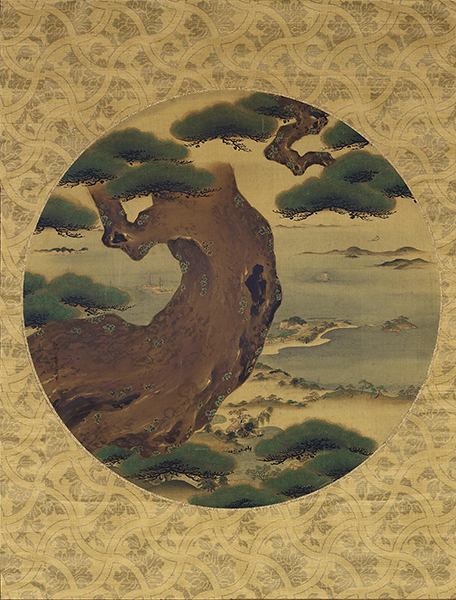Auspicious Friend for the New Year
Pine trees are one of the three “auspicious friends”—plants (along with bamboo and plum blossom) that help welcome the New Year in Japan. Pines are auspicious because they survive and don’t lose their bloom in winter and are green when they greet the New Year. This gnarly pine tree certainly exudes venerability to wish you a Happy New Year.
 |
| Kanō Isen’in Naganobu (1775–1828, Japan), Pine in a True View Painting. Ink and colors on silk, width of painting: 26 5/8" (67.6 cm). © 2021 Museum of Fine Arts, Boston. (MFAB-38) |
This type of "true view" painting was so-called because it was based on actual sketches made by the artist. This new trend in Kanō school painting evolved during the late 1700s, influenced in part by Western landscapes and by the woodblock landscapes of artists such as Ando Hiroshige (1797–1858) and Katsushika Hokusai (1760–1849), which were based on direct observation. The exaggerated "gnarliness" of the pine tree, stylized pine needles, and stage-like arrangement of the foreground, middle ground, and background are typical of the decorative style, while the logical indication of spatial recession is a reflection of Western influence.
The Kanō "school" of Japanese painting traditionally has its origins in the artist Kanō Masanobu (1434 –1530). At the time, Japanese painting was heavily influenced by the monochromatic landscape tradition of Japan, which in turn was influenced by Chinese ink paintings. The school maintained a leading position as artists of the military dictators and military nobility that ruled Japan from the 1400s to the 1800s.
Over the centuries, monochromatic painting was augmented by other styles within the Kanō school, including a decorative yamato-e style, such as this painting, which became synonymous with the school name. Yamato-e, which originally flourished during the Heian period (794-1185 CE), explored the use of bright colors in flat shapes contrasting with gold leaf backgrounds.
Kanō artists of this decorative wing, working mostly in large compositions meant to be part of mobile screens in large castles, reintroduced the Japanese love of color and decorative surface, contrasting with flat, featureless areas of gold leaf. Motifs continued to be traditional to Chinese and Japanese painting. This the revival of the decorative style evolved during the Momoyama period (1573–1615) and was fully developed by the Edo period (1615–1868). The rich and complex style of the Kanō school was mirrored by other schools that evolved during the Edo period, such as the Sotatsu and Korin-Kezan painters.
Kanō Isen'in Naganobu was the son of the seventh leader of the Kanō school, Kanō Yosenin Korenobu (1753 –1808). Naganobu was the eighth leader of the Kobikicho branch of the school, the highest-ranking painters of Tokugawa officials. He was trained by his father, who later said that he was "superior to me." Not only was he renowned for his large format screen and scroll paintings in the decorative manner, but also for his application of gold leaf in his monochromatic works.
Correlations to Davis programs: Explorations in Art 1E Grade 1: 1.1; Explorations in Art 2E Grade 1: 1.1; Explorations in Art 1E Grade 4: 1.6, 6.34; Explorations in Art 2E Grade 4: 1.8, 6.6; Explorations in Art 1E Grade 6: 5.26; Explorations in Art 2E Grade 6: 5.2

Comments